| Quote
: |
陶洪,刘慧英,彭昕欣,谢静,谢薇,黄婷.过敏性紫癜患儿临床特点及中医证候演变规律的研究[J].湖南中医药大学学报英文版,2023,43(5):935-939.[Click to copy
] |
|
| |
|
|
| This paper
:Browser 2239times Download 1062times |
| 过敏性紫癜患儿临床特点及中医证候演变规律的研究 |
| 陶洪,刘慧英,彭昕欣,谢静,谢薇,黄婷 |
| (湖南中医药大学第一附属医院, 湖南 长沙 410007;湖南中医药大学, 湖南 长沙 410208) |
| 摘要: |
| 目的 观察过敏性紫癜中医证候演变规律,探讨过敏性紫癜临床特点与中医证型的相关性。方法 对426例来自湖南中医药大学第一附属医院住院和门诊的过敏性紫癜(Henoch-Schönlein purpura, HSP)患儿临床资料进行回顾性分析,总结中医证候演变规律,比较患儿的一般资料、发病季节、诱发病因、实验室指标不同水平分布情况。结果 (1)HSP患儿男女发病比例相当,冬春季发病多,病程多在4周以内。(2)中医证型以风热伤络证、血热妄行证为多,其次是湿热痹阻证、阴虚火旺证、气不摄血证,发病诱因以感染多见,其中呼吸道感染最多见,统计学分析提示:不同中医证型在年龄、发病诱因上差异有统计学意义(P<0.05);实验室指标D-二聚体、白细胞介素-6 (interlenkin-6, IL-6)、免疫球蛋白A(immunoglobulin A, IgA)、CD4+/CD8+T在不同中医证型上差异有统计学意义(P<0.05)。(3)风热伤络证易演变为气不摄血证;血热妄行证易演变为阴虚火旺证。结论 (1)HSP中医证型上早期以风热伤络证、血热妄行证为主,后期常见阴虚火旺证、气阴两虚证;(2)HSP中医病机演变上,主要向虚、瘀发展。(3)D-二聚体、IL-6、IgA数值升高和CD4+/CD8+T数值偏低的现象主要集中在风热伤络证和血热妄行证。 |
| 关键词: 过敏性紫癜 中医证候演变规律 临床特点 D-二聚体 白细胞介素-6 免疫球蛋白A CD4+/CD8+T |
| DOI:10.3969/j.issn.1674-070X.2023.05.027 |
| Received:June 16, 2022 |
| 基金项目:湖南中医药大学中医学国内一流建设学科项目(4901-020000200208);湖南省中医药科研计划项目(2021080)。 |
|
| Clinical characteristics and evolution law of TCM patterns of Henoch-Schönlein purpura in children |
| TAO Hong,LIU Huiying,PENG Xinxin,XIE Jing,XIE Wei,HUANG Ting |
| (The First Hospital of Hunan University of Chinese Medicine, Changsha, Hunan 410007, China;Hunan University of Chinese Medicine, Changsha, Hunan 410208, China) |
| Abstract: |
| Objective To observe the evolution law of TCM patterns of Henoch-Schönlein purpura (HSP) and explore the correlation between clinical characteristics of HSP and TCM patterns. Methods A retrospective analysis was conducted on the clinical data of 426 children with HSP from the First Hospital of Hunan University of Chinese Medicine. The evolution law of TCM patterns was summarized, and the general information, onset season, inducing factors, and distribution of laboratory indicators at different levels of the patients were compared. Results (1) The proportion of HSP in male and female children was similar, with a high incidence in winter and spring. And the course of the disease was mostly less than 4 weeks. (2) The TCM patterns of HSP are mainly wind-heat injuring collaterals and reckless flow of blood due to heat, followed by a damp-heat obstruction, yin deficiency leading to fire hyperactivity and qi deficiency failing to control blood. Infection was the most common cause of the disease, especially respiratory tract infection. Statistical analysis showed that there were significant differences in age and pathogenesis among different TCM patterns (P<0.05). Laboratory indicators including D-dimer, interlenkin-6 (IL-6), immunoglobulin A (IgA), and CD4+/CD8+T showed statistically significant differences in different TCM patterns (P<0.05). (3) The pattern of wind heat injuring collaterals easily evolved into the pattern of qi deficiency failing to control blood; the pattern of reckless flow of blood due to heat easily changed into the pattern of yin deficiency leading to fire hyperactivity. Conclusion (1) In the early stage of HSP, the main TCM patterns are wind heat injuring collaterals and reckless flow of blood due to heat, and in the later stage, the common patterns are yin deficiency leading to fire hyperactivity and qi and yin deficiency. (2) In the evolution of TCM pathogenesis of HSP, it mainly develops into deficiency and stasis. (3) The elevated values of D-dimer, IL-6, and IgA and the low value of CD4+/CD8+T are mainly concentrated in the pattern of wind-heat injuring collaterals and reckless flow of blood due to heat. |
| Key words: Henoch-Schönlein purpura evolution law of TCM pattern clinical characteristics D-dimer interlenkin-6 immunoglobulin A CD4+/CD8+T |
|

二维码(扫一下试试看!) |
|
|
|
|


